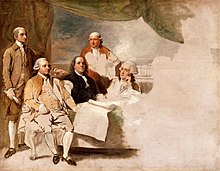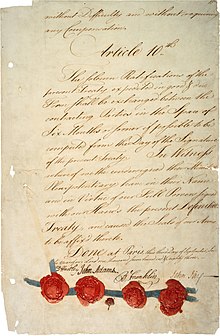Richard Oswald (merchant)
[1] In British North America he had large land holdings and owned slaves in East Florida, and held estates in both Georgia and Virginia.Oswald directed British planter Francis Levett, who formerly worked for the Levant Company, to locations in the colony of East Florida for his plantations, and urged East Florida's Governor James Grant to make generous land grants to Levett, whom Oswald called his "worthy friend" to whom he owed "particular obligations.Those he put forward for Nova Scotia included: a former governor (Thomas Pownall); the cartographer John Mitchell; Member of Parliament Robert Jackson; MP and Paymaster for the Marines John Tucker; and a judge of the Marshalsea Court, and cousin of adventurer Sir Michael Herries, Levett Blackborne, who was himself stepbrother to Thomas Blackborne Thoroton, brother-in-law of the Marquess of Granby.[14] The Company of Merchants Trading to Africa formed at this time had some close links to the Bance Island consortium, for example through Robert Scott and then George Aufrere.At the same time, Oswald associates like John Levett in Calcutta kept an eye on local trends, and adjusted their schemes to fit them.[17] In letters to British General and East Florida Governor James Grant, Oswald confided that at one dinner of investors in East Florida and Nova Scotia that "Oswald had been dining at the Duke's with Lord Granby, Mr. Thoroton, and others where jokes passed round the table about the many settlements that would be needed to satisfy Mr. Thoroton's nine children."Because of his prior experience living in America and his knowledge of its geography and trade, he had been consulted frequently by the North ministry about matters concerning the war.[22] After his death, his nephews and fellow slave traders John and Alexander Anderson, also with interests on Bance Island, were appointed executors of his estate.She died in London, and her funeral cortege took her body for burial in Ayrshire, having the effect of depriving Robert Burns of his lodgings.


Treaty of ParisBenjamin WestTemple FranklinHenry LaurensBenjamin FranklinJohn AdamsJohn JayScottishslave traderAmerican RevolutionNorth ministryAmerican War of IndependencePeace of ParisDunnetGlasgowfactorWar of the Austrian Successioncounting-housePhilpot LaneforageSeven Years' WarFerdinand of BrunswickKirkcudbrightshireAuchincruiveAyrshireEast FloridaLevant CompanyJames GrantThomas PownallJohn MitchellJohn TuckerMarshalsea CourtMarquess of GranbyAlexander GrantJohn BoydBance IslandSierra Leone RiverRoyal African CompanyCompany of Merchants Trading to AfricaarrackLivornoLord ShelburneAmericatreatyDuke of RichmondEleazer OswaldWilliam L. ClementsUniversity of MichiganJohann ZoffanyRobert BurnsGeorge OswaldInternet ArchiveUniversity of South Carolina Press